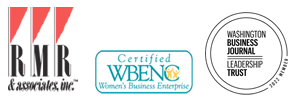Corporate Communication Training – Get Our Free Whitepaper!
 Speaking of corporate communication training for your company, RMR & Associates has helped roll out over 350 companies and products since it was started in 1987. Its hundreds of clients have made millions of dollars with RMR’s advice and assistance.
Speaking of corporate communication training for your company, RMR & Associates has helped roll out over 350 companies and products since it was started in 1987. Its hundreds of clients have made millions of dollars with RMR’s advice and assistance.
RMR is one of the largest corporate communication training firms owned by a woman in Maryland dealing with Business to Business (B-to-B) and Business to Government (B-to-G) clients. These clients trust RMR, because RMR delivers the promise of the proposal. Because RMR has proven processes and procedures that guarantee that your company gets the progress reporting you need to give you comfort and confidence that your project will be a success. Because RMR will execute the necessary tasks relentlessly to deliver the results that are the promise of your proposal.
RMR is also one of the only corporate communication training firms in the Washington DC area where the agency is also your one stop shop for other marketing vehicles that leverage your investment in your advertising program and give you the synergy that makes your integrated marketing program more than the sum of its parts.
- Public Relations
- Press releases
- Authored articles
- Feature articles
- Award Opportunities
- Speaking Opportunities
- Web Marketing
- Lead-Generating web sites
- Email marketing campaigns
- Search engine optimization (organic)
- Search engine marketing (AdWords)
- Trade shows
- Positioning and Branding
- Product launches
MEDIA TRAINING
Your CEO is squirming. Your chief technology officer speaks techie talk and not much else. Your comptroller likes numbers much more than people. But you need to enlist all of these people to speak to various media outlets about the present and future of your company or non-profit organization.
Here are some observations concerning challenges inherent in enlisting management types in talking to the media and advice he has for turning the minuses into pluses.
MEDIA DYNAMICS
Executives don’t understand media dynamics. A spokesperson needs to understand that the typical journalist is harried, has a deadline to meet, and sees the executive only as a way to an end, as a means to meet a deadline. Journalists typically have no time for people who are not going to give them good information, which is the first of many reasons the executives you work with need to listen to what you as media-relations pros tell them.
If you do what your PR person tells you, you’re going to maximize your chances of press getting it right. Media-relations managers have to drive home what expectations the executive speaker can realistically achieve through a media interview and connect those expectations to a set of behaviors and responses designed to deliver those expectations. Media-relations staffers also have to do their homework to provide executive spokespeople with information on the journalist’s responsibilities (deadlines, beat coverage, story purpose) and level of knowledge.
STRATEGIC MESSAGING
PR needs to frame messaging because that’s part of why executives don’t like speaking with the media. Journalists won’t shift their frame of reference for PR’s convoluted way of thinking. Deliver your message in terms reporters can understand and immediately consume so their questions are natural and easy. Then train your speaker to guide journalists beyond the sound bytes, through your message points so that an inverted pyramid story nearly writes itself through the interview.
JARGON
There are lots of ways to blow an interview. The best way is to mismatch language. As the media trainer, know the level of jargon that your spokespeople can use with the media without confusing them or turning them off to writing a story about your news. The second best way, is over-answering. The more you talk, the more that you risk snatching defeat from the jaws of victory. In other words, over-communicating even the best message bores journalists and bogs them down with too much data and they tune your speaker out.
We recommend PR and media-relations communicators sit in on interviews the press conducts with official company spokespeople. If the exec goes off on a tangent or generally sounds like a windbag, the media-relations representative can cut him or her off. Practice this in mock interviews before your spokespeople go live. When they start over-communicating, teach them to explain their answers and then stop.
TRUST
A lot of people just don’t trust the media, and trust is a difficult thing to teach. If your group’s management members are wary of the media, ask them to trust the process. They need not trust the individual they are talking to if they have mastered the company’s message.
You can’t control the media by being arrogant. Train spokespeople to establish power in the interview process and act confidently. Even if journalists ask the terrible “what if” questions, which put executives in hypothetical crises and ask how they would manage the company given those circumstances.
Your upper-management company representatives can refuse to answer sticky questions, but rather than turning down questions belligerently, ask them to answer without creating controversy. They can “bridge”, saying, “No, I’m sorry, our number of customers is proprietary information, but I can tell you that we have increased our customer base by 11 percent in each of the last three quarters.”
Keep these tips in mind and your media experience will be much smoother. Or, contact us here at RMR for more customized media training
